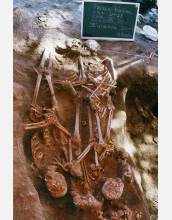All Images
News Release 06-019
Excavated Teeth Likely Came from First Africans Brought to the New World
Europeans may have imported slaves in the 1500s
This material is available primarily for archival purposes. Telephone numbers or other contact information may be out of date; please see current contact information at media contacts.

Upper incisor teeth recovered from the grave in Campeche, Mexico, show evidence of filing, a distinctive practice of some 16th-century Africans.
Credit: Courtesy T. Douglas Price
Download the high-resolution JPG version of the image. (737 KB)
Use your mouse to right-click (Mac users may need to Ctrl-click) the link above and choose the option that will save the file or target to your computer.

Digging in a colonial-era graveyard in Campeche, one of the oldest European cities in Mexico, archaeologists found and researchers chemically analyzed what they believe are the oldest remains of slaves brought from Africa to the New World.
Credit: Courtesy T. Douglas Price
Download the high-resolution JPG version of the image. (5.1 MB)
Use your mouse to right-click (Mac users may need to Ctrl-click) the link above and choose the option that will save the file or target to your computer.

Digging near the central plaza of the port city Campeche, located on Mexico's Yucatan Peninsula, archaeologists have uncovered evidence that suggest Africans were brought to the New World as slaves as long ago as the late 1500s.
Credit: Barry Carlsen
Download the high-resolution JPG version of the image. (111 KB)
Use your mouse to right-click (Mac users may need to Ctrl-click) the link above and choose the option that will save the file or target to your computer.


